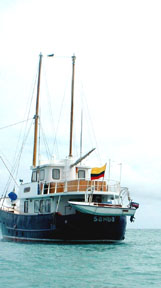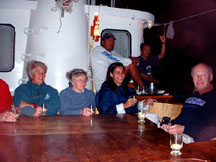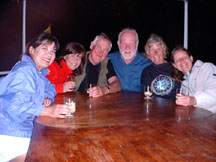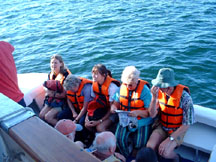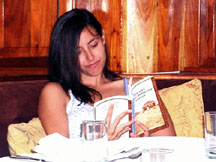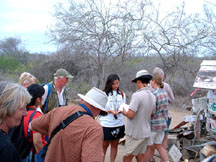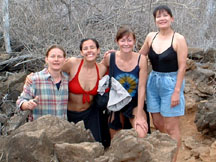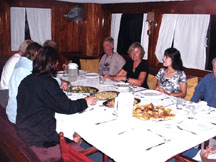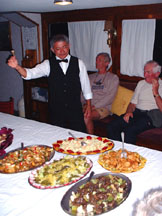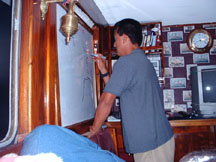|
Galapagos at Last! 
|
|
Most of the smaller pictures are "clickable" to see larger versions. Use the "back" button on your browser to return to this page. |
|
And now, at last, Galapagos. I assume most of you will have some idea of the significance of the Galapagos Islands, but let me just tell you that they are a small archipelago that straddles the equator some 600 miles west of the coast of Ecuador. They have the most highly protected, most studied and most written about ecosystem of anywhere on the planet. The first of these pieces of writing was a little essay entitled "The Origin of Species" by one Charles Darwin. Most of the islands have no human habitation, but the capital Port Ayora on Santa Cruz has about 11,000 full time residents. Only 800 visitors are allowed on the islands at any one time, and the fee for everyone entering the Galapagos National Park is $100. Most people sign up with a recognized tour company and cruise around on a ship with an official guide, visiting the islands one by one over the course of a week or ten days. There is no unsupervised access to most of the islands, so stringent is the level of protection that the world scientific community has imposed through the Ecuadorian government. The source of this powerful influence is economic: America and other countries are lavishing resources on the islands because of their unique scientific interest and Ecuador does not wish to do anything that might turn off the tap. It's an arrangement that works to everyone's advantage. Also on Santa Cruz is the Charles Darwin Research Station, one of the world's most prestigious scientific field stations, where research workers and volunteers from every nation come to study and take part in conservation work. The eventual aim of the station is to restore the ecology of Galapagos as closely as possible to what it was before the arrival of humans and to use it as a laboratory for the continued study of evolution and environmental change. What follows is mostly Jean's account from e-mails that we sent to our friends, and also ourselves, at regular intervals when we were within reach of an Internet Cafe. |
|
We found the
guide, Franklin a very fine and enthusiastic environmentalist who obviously loved his job. His dedication to the conservation of the island wildlife was absolute, all that he seemed to live for. The rest of the crew were very jolly and got on well with each other. The black cook played the guitar and sang and gave us a show on the last night. Apparently he was religious and it was all hymns that he was singing, though you wouldn't have thought so by the rhythm. Others played the maracas and various kitchen utensils. Although friendly enough the cook seemed to avoid conversation during the course of the cruise. We wondered if he might have been a creationist who had ended up in the wrong job.
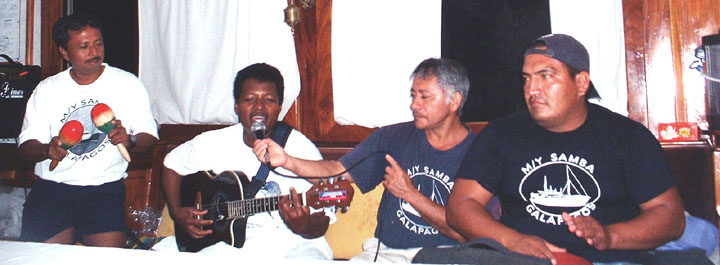 Left to right: Johnny the engineer, (?) the chef, Raoul the purser/waiter, Arturo the panga captain The ship was lovely, with six lower cabins, a dining room with a big wooden table and an interior lined entirely with wooden pannelling. It was made in the 1960s but was in spotless condition. The Captain was very house proud and wouldn't let us wear shoes inside, and made sure we got all the sand off us with a hose before we went to our cabins.There was an upper deck with a sitting area and a front deck where you could lie about and/or hang out your washing. We had a two-berth cabin with bunks and drawer storage under them, and an en suite toilet and shower. It was all a bit cramped and it was easier to dress, etc. one at a time. However, this was not really a problem. |
|
There were four single women: two friends from Sweden: - Michelle (43) who was a journalist and very extrovert, and Yvonne (also 43) who works with computers. Then a Californian called Debbie (a young 48) who is a counsellor for couples who are splitting up, helping them to do what's best for the children (I think it's called mediation and the couples with children are obliged to do it). The other woman was Kimberley (only 22) and from Puerto Rico, a trainee lawyer who had just finished at Harvard Law School. She was our unofficial interpreter and David's favourite, of course, though I must say she was friendly and smiley. I'll just come in here and say that I can't deny liking Kim: I liked everything about her, her looks, her personality, her intelligence, her friendliness... I understand she has a boyfriend in Boston. I hope he appreciates what a lucky young man he is. Okay, back to Jean's account. Although everyone got on well enough with one another and related in twos and threes I don't think we really gelled as a group. This didn't matter a great deal, it just meant that the meals were sometimes rather silent, though that quietness was good when we were looking at animals. We had to get up very early for our guided tours and everyone was keen to do that and always on time. |
|
(Note from David: I think I understand now why I was getting lower and lower in the water each time I went snorkelling.) |
|
Trips would either be an outing on the panga to look at life on an island (with a wet or dry landing) or a walk, or snorkelling, all with our guide and ourselves spotting fabulous things. The sea was pretty rough on the first day and after our first lunch several of us threw up fairly soon, including David and me. Unfortunately poor Mick also threw up over the side of the ship and his upper false teeth went with it, never to be seen again. He was the but of many jokes after that and couldn't eat the more chewy bits of our feasts, but was very good natured about it. The guide has assured him that if that part of the ocean should become dry land due to a volcanic upheaval in the near future, as has happened elsewhere in the islands, he will personally search for the missing teeth. I (David) discussed the possibility of a recovery based on precision scuba diving but unfortunately the incident had occurred in open ocean, many hundreds of meters deep. A mini sub would have been needed and I decided that the operation would be uneconomical. After that first night we took pills and weren't sick any more and after a couple more days didn't need to take pills at all. It was a nasty moment though, I thought: "I've spent all this money to puke up for a week". However, all was well. And so the adventure begins in earnest! The account in the pages that follow has been greatly edited down from Jean's original e-mails but will give you some flavour of what the days were like. We have also included only a fraction of the 400+ pictures that we brought back. As a matter of interest they were all taken on a Fuji FinePix 2600 Zoom, apart from a few underwater ones taken on the Sea & Sea MX10, few of which were good enough for inclusion here. We got through three 64 MB digital memory cards on this holiday.
|
